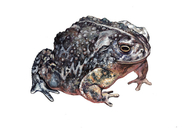|
Anaxyrus baxteri (Porter, 1968)
Wyoming Toad | family: Bufonidae genus: Anaxyrus |
 © 2009 Endangered Species International (1 of 1) |
|
|
|
Description Distribution and Habitat Country distribution from AmphibiaWeb's database: United States U.S. state distribution from AmphibiaWeb's database: Wyoming
Life History, Abundance, Activity, and Special Behaviors Trends and Threats Local and broad scale population declines are due to depredation, mostly due to introduced predators. Recent investigations involving implanted radio transmitters suggested predator attack primarily from mustelids (Parker 2000). Still, it is not often that naturally occurring predator-prey relationships are the cause of extinction of an entire population. The original decline may be due to a chytrid fungus, Batrachochytrium dendrobatidis, which has been implicated in amphibian declines worldwide. The current population at Mortenson Lake is infected with the fungus, and has been since 1989 (USFWS 2000). Translocation results on A. baxteri is discouraging (Seigel 2001). Possible reasons for amphibian decline Prolonged drought Comments
References
Baxter, G.T. and Stone, M.D. (1980). Amphibians and Reptiles of Wyoming. Wyoming Game and Fish Department, Cheyenne, WY. Parker, J., Anderson, S., and Lindzey, F. (2000). ''Bufo baxteri (Wyoming Toad). Predation.'' Herpetological Review, 31(3), 167-168. Seigel, R. A. and Dodd, C.K., Jr. (2001). ''Translocations of amphibians: proven management method or experimental technique?'' Conservation Biology, 16(2), 552-554. Stebbins, R. C. (2003). Western Reptiles and Amphibians, Third Edition. Houghton Mifflin, Boston. US Fish and Wildlife Service (USFWS) (2002). Wyoming Field Office Annual Wyoming Toad Report FY 02. Originally submitted by: Kenny D'Oyen (first posted 2004-02-20) Edited by: Tate Tunstall, Michelle S. Koo (2012-04-29) Species Account Citation: AmphibiaWeb 2012 Anaxyrus baxteri: Wyoming Toad <https://amphibiaweb.org/species/114> University of California, Berkeley, CA, USA. Accessed May 13, 2025.
Feedback or comments about this page.
Citation: AmphibiaWeb. 2025. <https://amphibiaweb.org> University of California, Berkeley, CA, USA. Accessed 13 May 2025. AmphibiaWeb's policy on data use. |




 Map of Life
Map of Life Hear calls at the Western Sound Archive.
Hear calls at the Western Sound Archive.